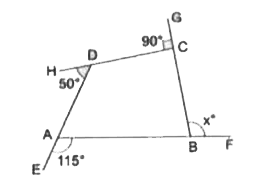Using a protractor, draw an angle of measure 128∘ . With this angle as given, draw an angle of measure 96∘.
Step-by-Step Solution
Step 1: Draw a Line Segment
- Start by drawing a horizontal line segment AB. This will be the base of your angle.
Hint: Use a ruler to ensure the line is straight and of a suitable length.
---
Step 2: Mark the Vertex
- Choose a point B on the line segment AB. This point will be the vertex of the angle.
Hint: Make sure point B is clearly marked, as it will be the center of your angle.
---
Step 3: Use the Protractor to Measure 128 Degrees
- Place the protractor such that the midpoint (the small hole) is exactly on point B and the line AB aligns with the 0-degree line of the protractor.
- From the 0-degree line, measure 128 degrees. Mark this point as C.
Hint: Ensure you read the protractor correctly; 128 degrees is measured from the 0-degree line in the clockwise direction.
---
Step 4: Draw the Angle
- Using a ruler, draw a line from point B to point C. This line represents the angle ∠ABC, which measures 128 degrees.
Hint: Make sure the line is straight and extends beyond point C for clarity.
---
Step 5: Bisect the Angle ABC
- To bisect ∠ABC, place the compass point on B and draw an arc that intersects both lines AB and BC. Let the points of intersection be P and Q.
Hint: Ensure the arc is drawn lightly so that it does not obscure your measurements.
---
Step 6: Draw Arcs from Points P and Q
- Without changing the compass width, place the compass on point P and draw an arc above the angle. Then, place the compass on point Q and draw another arc that intersects the first arc. Let the intersection point be D.
Hint: Make sure the arcs intersect clearly; this intersection point is crucial for the next step.
---
Step 7: Draw the Bisector
- Draw a straight line from point B through point D. This line bisects ∠ABC into two equal angles of 64 degrees.
Hint: Use a ruler to ensure the line is straight and accurately represents the bisector.
---
Step 8: Measure 32 Degrees for 96 Degrees
- To create an angle of 96 degrees, you need to add 32 degrees to the bisected angle of 64 degrees. Repeat the bisecting process for ∠ABD (which is 64 degrees).
- Draw arcs from points P and Q again as you did before, and mark the intersection as E.
Hint: This process will give you the additional angle needed to reach 96 degrees.
---
Step 9: Draw the Final Angle
- Draw a line from point B through point E. This line represents the angle ∠ABE, which measures 96 degrees.
Hint: Ensure that the angle is clearly marked and distinguishable from the previous angle.
---
Summary
- You have successfully drawn an angle of 128 degrees and then used that angle to construct a second angle of 96 degrees by bisecting and adding angles.
- Start by drawing a horizontal line segment AB. This will be the base of your angle.
- Choose a point B on the line segment AB. This point will be the vertex of the angle.
- Place the protractor such that the midpoint (the small hole) is exactly on point B and the line AB aligns with the 0-degree line of the protractor.
- From the 0-degree line, measure 128 degrees. Mark this point as C.
- Using a ruler, draw a line from point B to point C. This line represents the angle ∠ABC, which measures 128 degrees.
- To bisect ∠ABC, place the compass point on B and draw an arc that intersects both lines AB and BC. Let the points of intersection be P and Q.
- Without changing the compass width, place the compass on point P and draw an arc above the angle. Then, place the compass on point Q and draw another arc that intersects the first arc. Let the intersection point be D.
- Draw a straight line from point B through point D. This line bisects ∠ABC into two equal angles of 64 degrees.
- To create an angle of 96 degrees, you need to add 32 degrees to the bisected angle of 64 degrees. Repeat the bisecting process for ∠ABD (which is 64 degrees).
- Draw arcs from points P and Q again as you did before, and mark the intersection as E.
- Draw a line from point B through point E. This line represents the angle ∠ABE, which measures 96 degrees.
- You have successfully drawn an angle of 128 degrees and then used that angle to construct a second angle of 96 degrees by bisecting and adding angles.
Topper's Solved these Questions
Similar Questions
Knowledge Check
In the given figure, find the angle measure x.
 Ax=115Bx=150Cx=105Dx=151
Ax=115Bx=150Cx=105Dx=151Mirror drawing test is used to measure
Arate of learningBtransfer of learningCcreativityDinterest
Angle || Measurement
View SolutionAngle || Measurement
View SolutionUse a protractor to draw an acute angle, a right angle and an obtuse angle :
View SolutionDraw an angle of measure 155∘ and divide it into four equal parts.
View SolutionDraw an angle of measure 147∘ and construct its bisector.
View SolutionDraw an angle of measure 153∘ and divide it info four equal parts.
View Solution
